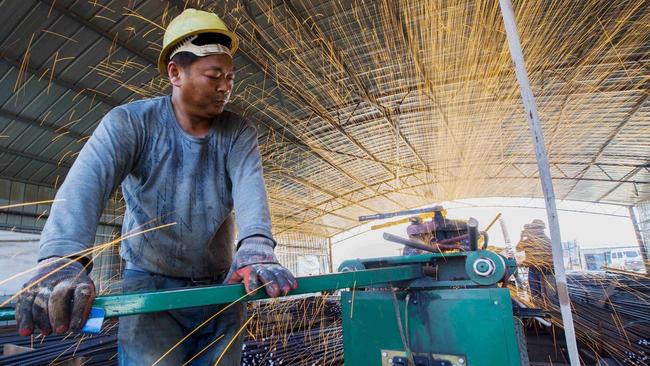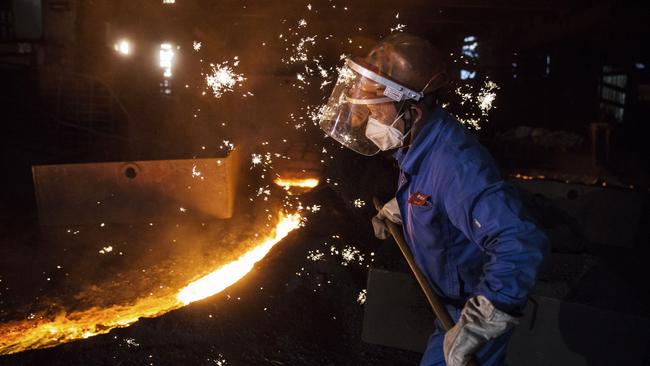Iron ore price at an almost two-year low as China’s demand stalls
China’s official figures show steel production in July was down 9 per cent on the previous month due to subdued demand, placing pressure on Australia’s iron ore producers.

Iron ore prices have dropped to 21-month low after China’s largest steelmaker put the industry on edge by saying the sector faced a crisis more acute than the downturns of 2008 and 2015.
According to the National Bureau of Statistics of China, that country’s steel production in July was 82.94 million tonnes, down 9 per cent on the previous month, as mills cut back on steel output due to subdued demand, lacklustre prices, and tightening margins.
This represented a 10 million tonne decline from May’s peak of 92.9 million tonnes and marked the lowest monthly total since February.
Output for the first seven months of 2024 fell 2.2 per cent on the previous year to 613.7 million tonnes. The subdued property sector, which makes up about 30 per cent of China’s steel consumption, was the key drag.
China’s infrastructure sector, which represents more than a quarter of China’s steel demand, failed to offset the decline in China’s property sector.
Iron ore’s price has dropped to its lowest level since November 2022, to $US95.25 a tonne, after topping $US144 a tonne on January 3, and the downturn has put pressure on major Australian iron ore producers.
Futures in Singapore were down as much as 1.9 per cent to $US93.85 a tonne on Thursday, intensifying the sell-off in mining stocks which has resulted in BHP’s shares falling 22 per cent so far this year and rival Rio Tinto 21 per cent over the same period.
Commonwealth Bank commodity analyst Vivek Dhar noted the warning by China Baowu Steel Group.
“It’s hard to compare 2024 directly to 2008 and 2015 given how much the steel supply chain and end‑use sectors have changed,” he said.
“However, what is clear over the last year is that average steel mill margins have been more negative than any other 12‑month period prior since at least November 2016.”
Mr Dhar said markets were trying to assess how low iron ore prices could fall.
“We think iron ore prices can drop to as low as $US90 a tonne given how negative steel mill margins have become,” he said.
“A key difference to the fall in iron ore prices earlier this year when steel mill margins were just as negative, is that seaborne supply is now at risk of exiting as prices move below $US100 a tonne.
“This would typically mean a slower price drop, but our concern is that the speed that iron ore prices can fall will likely be driven by the surprising deterioration in China’s near‑term steel demand.”

In May Chinese policymakers announced a funding package of 500bn yuan ($106bn) to purchase excess housing inventory for conversion to affordable housing.
However, markets estimated that spending closer to 2.5 trillion to 7 trillion yuan was required to absorb China’s excess housing inventory.
“While demand and supply factors have led to a subdued property sector in China, we believe supply factors, particularly improving the credit quality of China’s property developers, is key in alleviating the pressure on China’s property sector,” Mr Dhar said.
“China’s property sector, markets have been waiting for policymakers to provide additional funding for this supply-side measure.
“And with no announcement at the Third Plenum and the Politburo meeting that followed shortly after, hopes are fading that China is seriously going to solve its property crisis. These setbacks to steel demand hopes have also prompted iron ore prices lower.”
Soaring thermal coal and LNG prices in the wake of Russia’s invasion of Ukraine, supported by strong demand for iron ore and steelmaking coal, helped Australia’s export earnings reach a record $466bn in the year to June 2023.
Despite budget forecasts of a relatively rapid decline in the prices for key commodities, total export earnings are estimated to have dropped by only 10 per cent in the 2024 financial year, to $417bn, according to the latest quarterly report from the Department of Industry, Science, Energy and Resources.
The nation’s export bonanza that has driven the first back-to-back surpluses in 16 years has faded, but will not collapse, the report suggested.

